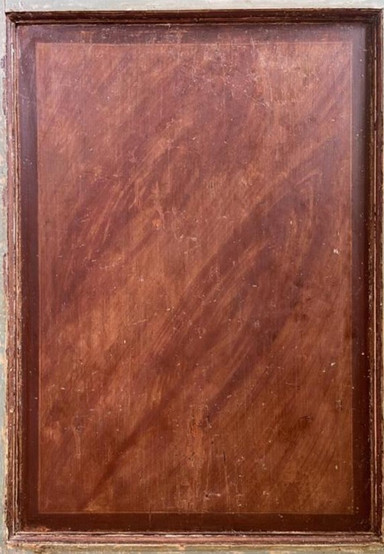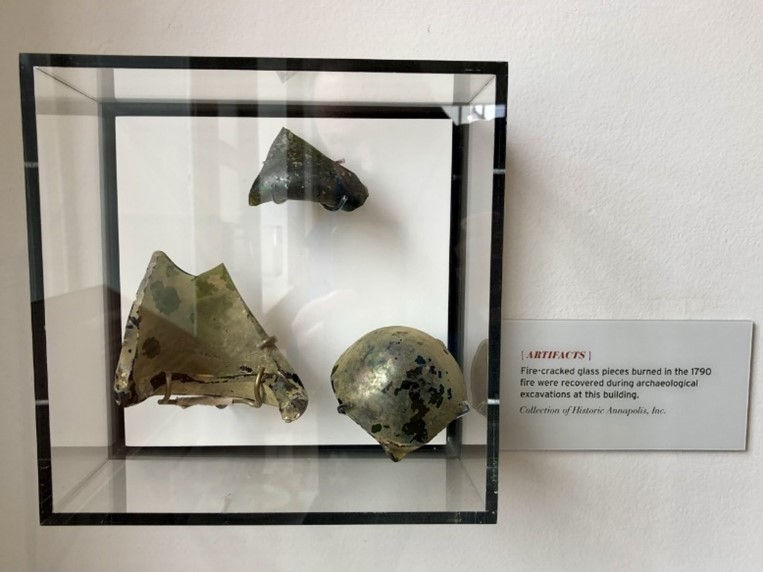Waves of Grain
- HistoricAnnapolis

- Aug 15, 2023
- 4 min read
In April 2022, the James Brice House’s conservation team began exposing late-eighteenth-century faux wood graining on wainscoting in the building’s Stair Hall. Because laboratory analysis was previously completed, we knew two generations of graining were present and concealed beneath layers of varnish and oil paint (Image 1). The process of analyzing samples taken from the Brice House under a microscope in combination with what is revealed on site provides our team with a more complete and accurate understanding of the finishes we work to preserve and replicate.

Image 1: This cross-section of a sample taken from the Stair Hall wainscoting provides evidence of the two graining campaigns (Source: Susan L. Buck, 2018).[1] A common decorative practice in centuries past, faux graining transforms a low-cost material, like the pine used for the Stair Hall wainscoting, into a more expensive one such as oak, walnut, and mahogany (Image 2). This technique is achieved by building up layers of opaque and translucent finishes to replicate the desired species of wood.[2] Ultimately, the graining pattern is created by manipulating a pigmented translucent layer(s) while it is still wet with tools such as brushes, combs, sponges, and rags (Image 3).

Image 2: A plate from an 1872 grainer’s showing the process of layering finishes to achieve the appearance of Honduras Mahogany.[3]

Image 3: An example of a graining brush and comb from an 1827 grainer’s handbook.
Previous archival research and examination of the staircase led our team to believe that the two faux graining campaigns happened in rapid succession. In 1773, stylistic changes made to the staircase likely initiated the second campaign while the house was still under construction.[4] This knowledge allowed our team to narrow our goal to exposing the second campaign, but still left us with challenges and unknowns. Eighteen subsequent generations of finishes were on top of the graining (Image 4). We needed a method to evenly remove these layers without damaging the graining. If achievable, in what condition would we find this 250-year-old decorative finish? The glazes used in graining are thin and fragile, and especially difficult to reveal. Our expectations were low based on past experiences revealing eighteenth-century graining. At the very least, we hoped to find enough evidence to recreate the graining.

Image 4: A cross-section of a sample taken from the Stair Hall wainscoting showing evidence of 22 finishes campaigns (Source: Susan L. Buck, 2018).[5] Through rounds of trials and testing, we developed a system for removing all of the overpaint without damaging the graining. To our delight, layers of dark brown varnish (generations #4-9) provided a buffer between the graining and the later layers of oil paint (Image 4). Our system softened the oil paint layers and liquefied the varnish layers, leaving them easy to remove, without disturbing the graining (Images 5 and 6).
Image 5 (left) and Image 6 (right): A panel before and after the layers of dark brown varnish are removed (Source: Chris Mills, 2022).
Our process revealed faux mahogany wood graining in remarkable condition for its age (Image 7). Clearly skilled, the painter executed the graining in distemper, a water-based finish made of chalk and pigment bound in animal glue, and often diluted with beer. These materials lend distempers their soft appearance and result in finishes that are delicate and easily damaged.
We found that the graining is faint or altogether missing in certain areas; this is partially attributable to the 1950s-era renovations to the building (Image 8). There are also gouges and scrapes present, typical damage for wainscoting in a high-traffic area like a stairwell. Additionally, a few panels are slightly detached. Prior to proper climate control in the building, fluctuating moisture levels would have caused these panels to expand and contract; not all of the panels returned to their original state.
Image 7 (left): Faux graining likely dating to the 1770s in excellent condition (Source: Chris Mills, 2022). Image 8 (right): Graining that was partially burned off of the wainscoting during the 1950s (Source: Kelsey Britt, 2022).
Moving forward, the conservation team prepared the wainscoting for in-painting. First, necessary fills and repairs were made using reversible and/or traditional materials. Where the pattern is missing or faded, they in-painted the missing or damaged layer. The goal of in-painting is never to recreate, make up or overpaint, only to place pigment where the original finish is missing. We designed an in-painting process that allows for the removal of any finishes we add, layer by layer, without damaging the second graining campaign below. For conservators, it is imperative that our work is documented, distinguishable from the building’s historic fabric, and reversible. This ensures that what exactly remained of the graining we exposed can always be revealed again in the future.

-Contributed by Kelsey A. Britt, Conservator
Footnotes [1] Susan L. Buck, “Cross-section Paint Microscopy Analysis Revised Report, Interior Woodwork, Plaster and Doors, Overpaint Removal Testing, Brice House, Annapolis, Maryland,” (July 2018): 23. [2] Lisa Oestreicher, “Imitation Timber Graining in the 18th and 19th Centuries,” The Building Conservation Directory (2014): https://www.buildingconservation.com/articles/timber-graining/timber-graining.htm. [3] Nathaniel Whittock, The Decorative Painters’ and Glazier’s Guide (London: Isaac Taylor Hinton, 1827), 38. [4] Willie Graham, “The Significance of a Written Record: Interpreting the James Brice House,” National Trust for Historic Preservation Forum Blog, April 17, 2018: https://forum.savingplaces.org/blogs/special-contributor/2018/04/17/the-significance-of-a-written-record-interpreting. [5] Buck, 24.
















Comments